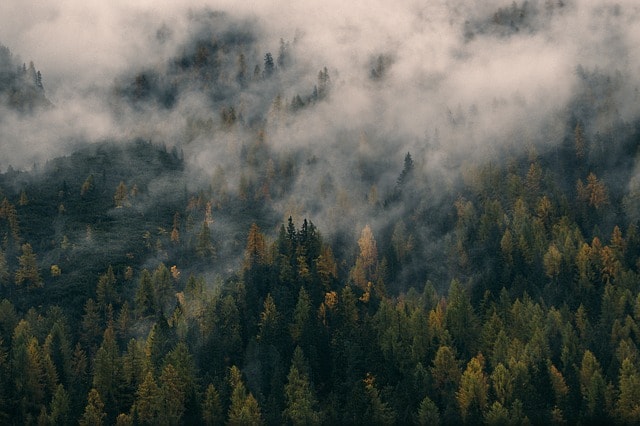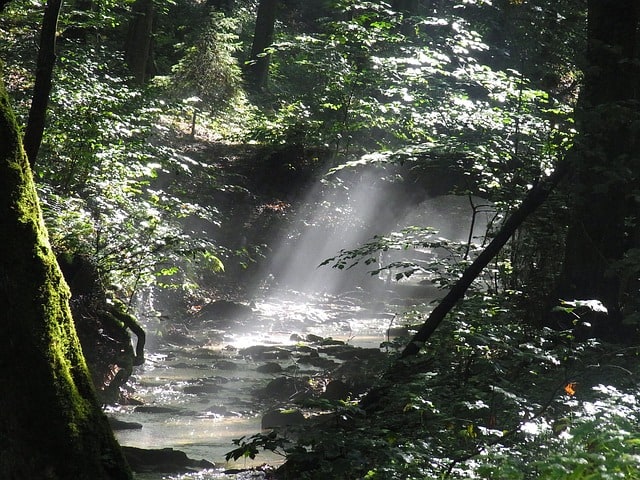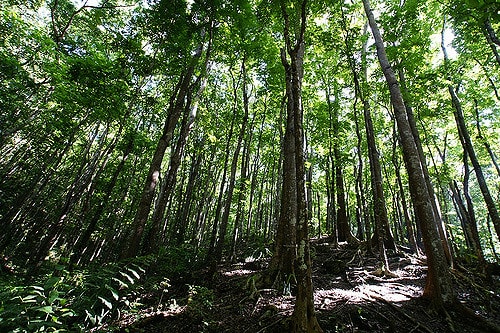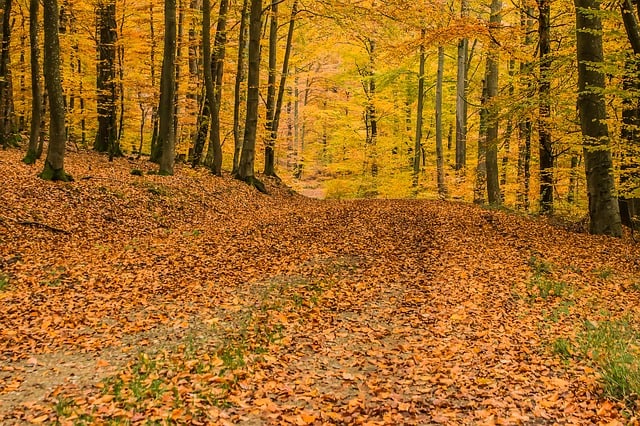Temperate Rainforest Biome: Climate, Precipitation, Location, Seasons, Plants and Animals

We are fast losing earth’s greatest natural treasures when we are just starting to appreciate their unique value. Rainforests once attributed to 14% of the entire earth’s cover. Today, the figure has dropped to a measly 6%, and biologists have warned that the remaining rainforests could be decimated in the next 40 years. Rainforest deforestation is contributing mightily to the loss of rainforests. If this practice goes on unabated, almost half of the animal and plant species in the world would be threatened or destroyed. That said, it is essential to be knowledgeable about rainforests in order to initiate informed actions to preserve them. Rainforest biomes are divided into two; Tropical rainforest biomes and temperate rainforest biomes. We are going to look at temperate rainforest biomes particularly.
A Temperate rainforest biome is a type of rainforest biome occurring in a temperate climate. To put it clearly, temperate rainforests experience vast amounts of rainfall but feature a cooler average temperature than tropical rainforests.
Climate
Temperate rainforests are characterized by mild climates or temperatures. Essentially, these areas do not experience extremely cold or extremely hot temperatures. Temperate rainforests have two different seasons. One season (winter) is quite long and wet, and the other (summer) is short, dry, and foggy. Throughout the long wet season, the temperature hardly falls below freezing point, which is 0°C and 32°F. Throughout the short, dry, and foggy season, the temperature hardly exceeds 27°C or 80°F. This pretty much explains why this biome is referred to as temperate rainforest.
Also in summer, when it’s relatively dry, the weather is considerably cool as the fog supplies sufficient moisture to enable the rainforest to thrive. Ideally, the fog contributes 18-30 cm (7-12 in) of precipitation every summer. These biomes are so mild due to their closeness to the ocean on one side and mountain ranges on the other. During winter months, the ocean water emits heat leaving the coastal areas warmer, and absorbs heat during summer months, leaving the coastal areas cooler.
Temperature
The average temperature of temperate rainforest is around 18-27C (64-80F). The temperature varies depending on the time of year as well as the location within the rainforest. However, in general, the temperature is cooler than in tropical rainforests. Moreover, the temperature can also vary greatly within a single rainforest location.
Possible weather conditions in temperate rainforests include moist, cool, and misty mornings and evenings, followed by hot, sunny days. Parts of the forest may be very chilly at night while other parts may be quite hot during the day. However, precipitation is usually moderate and frequent throughout the year.
Precipitation
Considering the word ‘’rain” is found in the word ‘’rainforest,” it tells you right off that this biome receives plenty of rainfall. Temperate rainforests receive a great deal of rainfall due to their location near the equator. The annual rainfall averages between 1,600 and 2,400 mm (60-100 in). The amount of rainfall also depends on location. For example, in the Amazon rainforest, the rainfall is much higher than in the temperate rainforests of North America.
The average annual precipitation of a temperate rainforest biome is 200cm. In much warmer areas, the average rainfall goes up to about 350 cm annually. However, this precipitation is not uniform throughout the year. It is quite variable, with a majority of it falling during the wet and long seasons.
Location
Temperate rainforests are located along some coasts in temperate zones. The biggest temperate rainforests are located on the Pacific coast of North America. They extend from Oregon to Alaska for about 1,200 miles. Smaller temperate rainforests also exist. They can be located on the southeast coast of Chile, South America. A few other coastal strips exist that have temperate rainforests such as small parts in the U.K., New Zealand, Japan, South Australia, and Norway.
Soil
Temperate rainforest soil is characterized by its dark color, high levels of organic matter, excellent water-holding capacity, and high nutrient levels. These features make it an ideal habitat for a multitude of plant and animal species.
The temperate rainforest biome is characterized by soil that is created through the decomposition of living organisms that have been present in the region for an extended period. This process produces a particular type of soil composed of high levels of organic matter, imparting it with dark brown coloration and rich nutrient composition. Furthermore, the organic matter facilitates water and nutrient retention, making it a suitable habitat for an array of flora and fauna.
Temperate rainforest biome soil can vary greatly from one region to another. In the Pacific Northwest region of the United States, for example, the soil is typically composed of a mix of clay, silt, and sand. This soil is especially rich in nutrients, such as nitrogen and phosphorus, which are essential for plant growth. In the Appalachian region of the United States, the soil is composed of more clay and less sand. This soil is less rich in nutrients, but it still contains high levels of organic matter.
Soil scientists are still working to understand the full effects of temperate rainforest biome soil on plant growth and biodiversity. However, research suggests that this type of soil is an essential part of the ecosystem. It helps to support a wide variety of plants and animals, and it provides them with the resources they need to thrive.
Seasons
Temperate rainforests experience an extended growing season. As opposed to tropical rainforests, temperate rainforests experience major seasonal changes. Animals living in the temperate rainforest must develop adaptation to the ever-changing seasons. Animals that are not able to adapt migrate in the winter. Leaves of temperate rainforest trees change color and drop in the autumn. They then regrow in spring. The broad, flat leaves of temperate rainforest trees lose water fast. Winter months normally leave the ground frozen, making it hard for them to absorb water. The result is a massive drop off of leaves. The trees in this biome stay dormant and blossom again during spring.
Plants
As opposed to tropical rainforests, temperate rainforests consist of only 2 layers of vegetation; the emergent layer and the canopy layer. The understory layer and the forest floor consist of less vegetation. The tallest trees in rainforests have their leaves typically approximately 15 to 30 centimeters from the ground, including a dense layer of small trees and shrubs beneath, at about 5 to 10 meters. This is the real reason the soil in temperate rainforests receives a lot more light than its tropical counterparts. The undergrowth in temperate rainforests is lush, consisting mainly of mosses, lichens, and ferns.
In the course of growth during spring, when the tree leaves have not wholly formed, there is a lot of light penetrating the forest floor. This aspect allows plant species to thrive on the ground, which explains why plant species that exist on the ground surface grow, flower, and produce fruits before late summer. Later on, sciophilus plants (plant species that love shade) begin to grow. These plant species have developed immaculate mechanisms to harness and utilize low-light intensity, which gives them the ability to get by even when the vegetation or greenery grows and entirely covers the soil below.
The main kinds of trees found in the temperate rainforest biome include oaks, beeches, walnut trees, lime trees, sycamores, aspens, elms, tulip trees, and birches. Below is a highlight of some of the tree species:
-
Oak
Oaks are tree species that can grow up to 40 m tall. They have impressive lifespans (500 to 100 years). Oak trees are predominant in tropical mountain regions (Himalayas, Mexico, and Indonesia), temperate climates (Europe, North America, and Asia), and Mediterranean climates (California and Mediterranean areas. Oak trees are highly valued by humans since they are used to make furniture, timber, stairs, railway sleepers, casks, and parks.
-
Beeches
These tree species can grow up to 40 meters tall and consist of huge, dome-shaped foliage. They bear fruits, which are commonly known as beech nuts. Beech nuts mimic chestnut husks. They also have thorns. However, the thorns are much softer and rounded, which means they can’t prick. Beeches do well in wet conditions, with moldy and airy soils, but far from harsh winter frost. These tree species are prevalent in Western and Central Europe, where they are mostly harvested to make timber.
-
Walnut trees
These are large tree species that grow up to 20 meters tall. They bear naturally fleshy stone fruits. Walnut trees are found almost everywhere. Their timber is harnessed to make furniture. They thrive in temperate climates with the United States being the largest producer.
-
Lime trees
Lime trees are characteristically long-trunked and elegant and can grow up to 30 meters tall. They come in different types, with the Tilia platyphyilos being the most common. Lime trees also grow wild and can be found along river banks, in bushes, rocks, coppices, and sunny slopes in areas of central Europe. They are commonly used to beautify gardens and parks and to shade city trees.
-
Aspens
These tree species are generally medium-sized and can grow up to 25 meters tall. They experience fast growth. They thrive in warm and sunny regions. Aspens are sprinkled all over central Europe. However, they are relatively few in Western Europe. They’ve proved, over the years, to be resilient (not affected by industrial waste), which is why they commonly grow in towns and cities.
-
Birches
Birches originate in Southeast Asia and Europe and thrive in sandy and peaty soils. They like areas with plenty of sunshine and mostly grow in small groups in mountainous and hilly regions together with broad-leafed and coniferous trees. The decorative color of their leaves and bark along with their beautiful deportment is the reason why they are used as ornamental trees.
-
Elms
Elms originate in Southwest Asia, Europe, and North Africa. They are classified as Ulmaceae plants and can grow up to 30 meters tall. Their greenery is hemispherical shaped, with thin and pale brown branches. Their flowers are attractively small and red.
Animals
Compared to tropical rainforest biomes, temperate rainforest biomes harbor very few mammals due to the absence of a series of sophisticated layers and the fact that the vegetation is seasonal. In summer months, the animal species of this ecosystem feed particularly on winged seeds and wall nuts that keep for a long duration. Fruits produced by the rose tree, apple tree, gooseberry, Hawthorne, and others almost always ripen at the same time (during late summer) and are chiefly used in summer for fat storage.
There is a huge diversity of life in temperate rainforest biomes. Frogs, turtles, insects, birds, spiders, and salamanders are just some of the animal varieties found here. Bird species like cardinals, broad-winged hawks, pleated woodpeckers, and snowy owls exist in this biome. Some of the mammals present in this biome include raccoons, porcupines, red foxes, white-tailed deer, and opossums. Let’s go into more detail about each of these.
-
Raccoons
Raccoons are medium-sized mammals found in temperate rainforest biomes. They are known for their distinctive black and white fur, as well as their cleverness and naughty behavior. They mostly feed on fruits, nuts, and small animals.
-
Porcupines
Porcupines are rodents that have a coat of sharp quills for protection. They are found in temperate rainforest biomes, where they feed on vegetation like bark, roots, and leaves.
-
Red Foxes
Red Foxes are medium-sized mammals that are widely distributed throughout temperate rainforest biomes. They are easily recognizable due to their deep red fur coats, white-tipped tails, and black legs and ears. They mainly feed on small mammals, birds, and insects.
-
White-tailed Deer
These are large, hoofed mammals found in temperate rainforest biomes. They have reddish-brown coats with white patches on their tail, legs, and underbelly. They mainly feed on grasses, shrubs, and fruits.
-
Opossums
Opossums are small mammals found in temperate rainforest biomes. They are usually grayish-brown in color and have long, prehensile tails. They mainly feed on fruits, nuts, and small animals.
Facts
Some of the major facts about temperate rainforest biomes include the following:
- Temperate rainforest biomes are found all over the world, in different climates and locations.
- They are located in North America, Europe, and Asia
- They are resilient (not affected by industrial waste), which is why they commonly grow in towns and cities.
- They are characterized by a temperate climate with high humidity levels
- They have high biodiversity, with a large variety of plant and animal species.
- The vegetation is seasonal, with most species in bloom during the summer months
- They are home to many different types of animals, including frogs, turtles, insects, birds, spiders, and salamanders.
- The greenery of temperate rainforest biomes is often used as a decorative element in architecture and landscaping.
Conclusion
In summary, temperate rainforest biomes are a unique type of biome that is found all over the world. They are characterized by a temperate climate with high humidity levels, high biodiversity, and seasonal vegetation. They are resilient and can grow in towns and cities, making them a popular option for urban dwellers.
To ensure the longevity of these vital ecosystems for future generations, we must recognize their value and increase our knowledge of the species that inhabit them.






